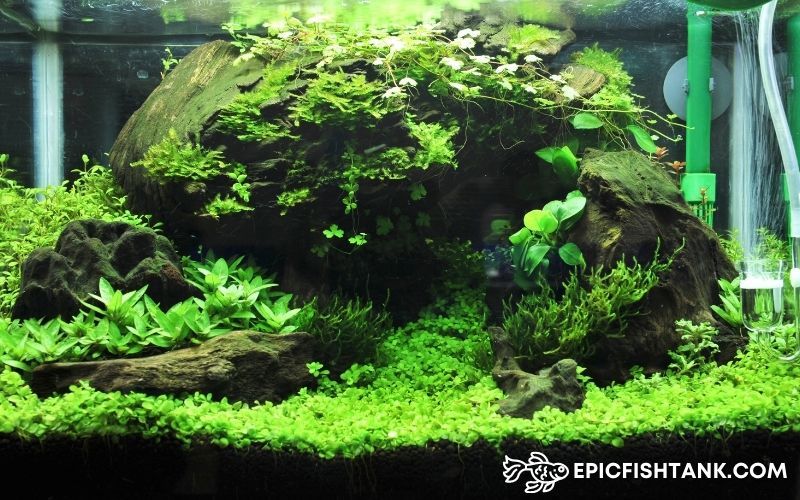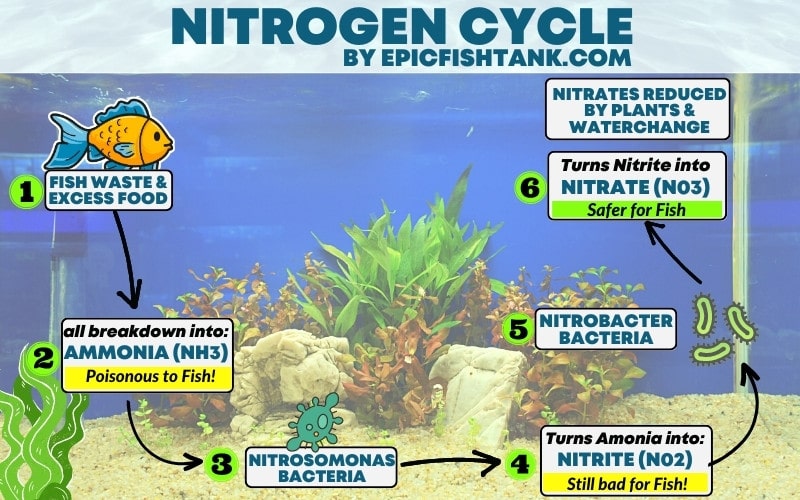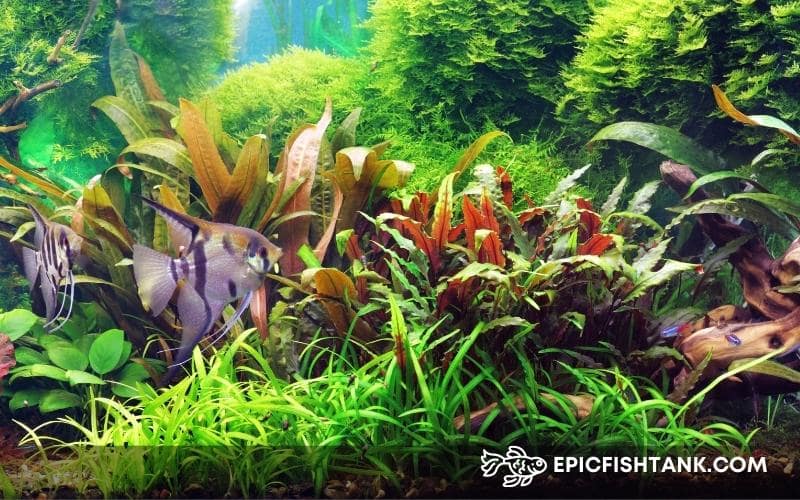The Aquarium Nitrogen Cycle Processes Explained
Ready to learn about the nitrogen cycle? In this guide, we will break down the process step by step, making it easy for even the most novice of fishkeepers to understand.

What is the Nitrogen Cycle?
The Nitrogen Cycle is the process by which harmful nitrogen compounds, such as ammonia and nitrite, are converted into less harmful compounds, such as nitrate.
The Nitrogen Cycle can be broken down into four main stages:
| Stage of Nitrogen Cycle | Description |
|---|---|
| Ammonification | Fish waste, uneaten food, and dead plant matter are broken down by bacteria, releasing ammonia (NH3) into the water. |
| Nitrification | Ammonia is converted to nitrite (NO2) and then nitrate (NO3) by nitrifying bacteria. |
| Assimilation | Nitrogen is taken up by plants and incorporated into amino acids, nucleic acids, and other biomolecules. |
| Denitrification | Nitrate is converted back to nitrogen gas (N2) by denitrifying bacteria, completing the cycle. |
Why it’s Important?
The Nitrogen Cycle is important for fish tanks because it’s an essential process for maintaining the health and well-being of the fish and other aquatic life in a fish tank. It helps to keep the water clean and safe, supports plant growth, and maintains biodiversity.
The Nitrogen Cycle is essential for a thriving aquarium, and our helpful table shows why!
| Importance | Description |
|---|---|
| Maintaining water quality | The nitrogen cycle helps to remove harmful ammonia and nitrite from the water and keep the water clean and safe for fish and other aquatic life. |
| Supporting plant growth | Nitrogen is an essential nutrient for plant growth, and the nitrogen cycle plays a critical role in supporting the growth of aquatic plants in the fish tank. |
| Maintaining biodiversity | The nitrogen cycle is critical for maintaining biodiversity in the fish tank as it enables plants to grow, which in turn supports the entire food web. |
| Supporting the biofilter | The bacteria that convert ammonia and nitrite to nitrate play a critical role in the fish tank’s biofilter, which helps to keep the water clean and clear. |
EpicFishTank Tips :
If you are new to caring for Betta fish, Guppies, or Goldfish, it is important to understand the Nitrogen Cycle. This natural process helps keep the aquarium water clean and safe for your fish by breaking down harmful toxins.
Nitrogen Cycle Processes Explained
Visualize the Nitrogen Cycle with this infographic! Get an inside look at how it works in your fish tank, from ammonia entering to being recycled back into the nitrate.

Step 1: The Nitrogen Cycle in fish tanks begins with the introduction of ammonia, which can come from various sources such as fish waste, uneaten food, and organic matter.
Step 2: The first stage of the Nitrogen Cycle involves the conversion of ammonia into nitrite by a bacterial species known as Nitrosomonas.
Step 3: In the second stage, Nitrobacter, another type of bacteria, converts the nitrite into nitrate.
Step 4: Nitrate buildup in the fish tank can be controlled through regular water changes or through the use of live plants, which have the ability to absorb nitrate as a nutrient.
Step 5: The final stage of the Nitrogen Cycle involves the conversion of nitrate into nitrogen gas, which can then escape the tank through the water surface. This process is facilitated by certain species of beneficial bacteria.
Step 6: To maintain a healthy Nitrogen Cycle in a fish tank, it is important to establish a proper balance of fish, plants, and bacteria. Overcrowding or overfeeding can lead to an accumulation of waste and an imbalance in the Nitrogen Cycle.
EpicFishTank Tips :
To ensure the maintenance of a healthy Nitrogen Cycle, it is essential to regularly test the water for ammonia, nitrite, and nitrate levels and make adjustments as necessary to maintain a balance.
The Two Nitrogen Cycle Methods
💡There are two main methods of cycling a tank; the fish-in and the fishless cycle.
Fish-In Cycle
The first method of cycling is called “fish-in” because you add fish to your tank during the process. You must first check that all necessary supplies such as food and filters are available in order to create an ideal living atmosphere for your fish.
During this period, you need to be sure to test the water regularly and adjust levels as needed. Once ammonia levels reach 0ppm, nitrite levels rise until they reach 0ppm indicating that your tank has completed its cycle and is ready for fish.
Fishless Cycle
The second method of cycling is known as “fishless” cycling, which involves introducing beneficial bacteria into your aquarium without adding any fish right away.
To set up a fishless cycle, you will need to begin by introducing ammonia into the water and testing levels frequently over time. As with the fish-in cycle, when ammonia levels reach 0ppm and nitrite levels reach 0ppm, it indicates that the cycle is complete and your tank is ready for fish!
Best Nitrogen Cycle Explanation Video
This awesome YouTube video explains everything so newbies can keep their tank healthy and their finned friends happy! Plus I’m gonna tell you how to start this process super fast -so your fishes will be swimming soon!
FAQs
What Are Common Sources of Ammonia in an Aquarium?
Common sources of ammonia in an aquarium include fish waste, uneaten food, decaying plant matter, and decomposing animal matter such as shrimp shells.
These sources produce toxic ammonia that accumulates in the tank unless it is converted into other forms through the aquarium nitrogen cycle.
How Can I Tell If My Aquarium Has an Established Nitrogen Cycle?
You can usually tell if your aquarium has an established nitrogen cycle by testing for ammonia, nitrite, and nitrate levels.
💡If your tank has zero readings for ammonia and nitrite but elevated levels of nitrate, then this indicates that the aquarium nitrogen cycle is established and functioning correctly.
Final Words
In conclusion, the Aquarium Nitrogen Cycle is a natural process that helps maintain a healthy balance of nutrients in aquariums. It involves several steps including ammonia conversion into nitrite and nitrate and finally removal of nitrate through regular water changes or plant uptake.
Taking the time to research and understand this process can help ensure that aquarium owners sustain a thriving fish population and remain vigilant in their aquarium upkeep.
With a better understanding of this process comes further enjoyment from the hobby while having peace of mind that your fish are safe from hazardous levels of Nitrogen waste buildup.
Glossarium
- Ammonia: A toxic compound that is produced when organic matter decomposes.
- Nitrite: A less toxic form of ammonia, it is still harmful to fish in high concentrations.
- Nitrate: The least poisonous form of nitrogen, it can still cause problems if it accumulates in an aquarium.
- Nitrosomonas: Bacteria which convert ammonia to nitrite
- Nitrobacter: Bacteria which convert nitrites to nitrates
- ppm – parts per million; it is a measurement of the concentration of a substance present in water, used to measure the levels of ammonia and nitrite.
References
- fdacs.gov | Aquarium Water Quality: Nitrogen Cycle
- kb.rspca.org.au | Why is an understanding of the nitrogen cycle important when setting up a fish aquarium?
Author
Reza is a digital marketer and an avid freshwater aquarist. He's been keeping fish tanks for more than 10 years and has always been fascinated by the delicate balance of life in water. Reza loves to share his knowledge about both digital marketing and fishkeeping with others, and he is always happy to help new aquarists get started in this rewarding hobby.
Wibisono is a freshwater fish breeder who raises and breeds different species of ornamental fish like betta, guppy, flowerhorn, and goldfish. He has been in the business since 2018 and exports his fish to different countries. He is committed to providing high-quality and healthy fish to his customers.

